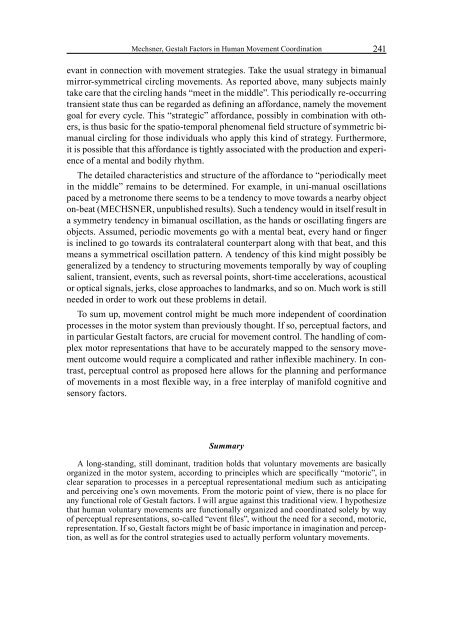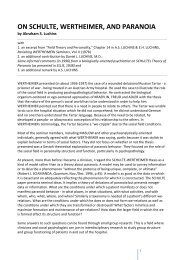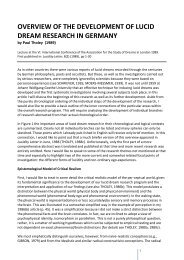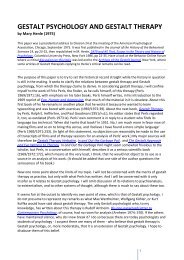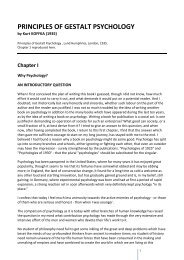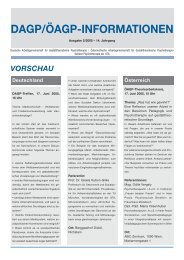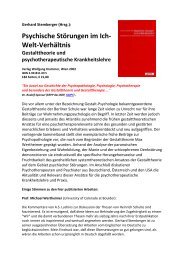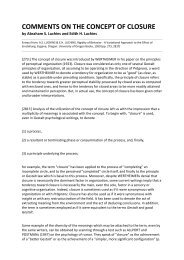Gestalt Factors in Human Movement Coordination - Society for ...
Gestalt Factors in Human Movement Coordination - Society for ...
Gestalt Factors in Human Movement Coordination - Society for ...
You also want an ePaper? Increase the reach of your titles
YUMPU automatically turns print PDFs into web optimized ePapers that Google loves.
Mechsner, <strong>Gestalt</strong> <strong>Factors</strong> <strong>in</strong> <strong>Human</strong> <strong>Movement</strong> Coord<strong>in</strong>ation 241evant <strong>in</strong> connection with movement strategies. Take the usual strategy <strong>in</strong> bimanualmirror-symmetrical circl<strong>in</strong>g movements. As reported above, many subjects ma<strong>in</strong>lytake care that the circl<strong>in</strong>g hands “meet <strong>in</strong> the middle”. This periodically re-occurr<strong>in</strong>gtransient state thus can be regarded as def<strong>in</strong><strong>in</strong>g an af<strong>for</strong>dance, namely the movementgoal <strong>for</strong> every cycle. This “strategic” af<strong>for</strong>dance, possibly <strong>in</strong> comb<strong>in</strong>ation with others,is thus basic <strong>for</strong> the spatio-temporal phenomenal field structure of symmetric bimanualcircl<strong>in</strong>g <strong>for</strong> those <strong>in</strong>dividuals who apply this k<strong>in</strong>d of strategy. Furthermore,it is possible that this af<strong>for</strong>dance is tightly associated with the production and experienceof a mental and bodily rhythm.The detailed characteristics and structure of the af<strong>for</strong>dance to “periodically meet<strong>in</strong> the middle” rema<strong>in</strong>s to be determ<strong>in</strong>ed. For example, <strong>in</strong> uni-manual oscillationspaced by a metronome there seems to be a tendency to move towards a nearby objecton-beat (MECHSNER, unpublished results). Such a tendency would <strong>in</strong> itself result <strong>in</strong>a symmetry tendency <strong>in</strong> bimanual oscillation, as the hands or oscillat<strong>in</strong>g f<strong>in</strong>gers areobjects. Assumed, periodic movements go with a mental beat, every hand or f<strong>in</strong>geris <strong>in</strong>cl<strong>in</strong>ed to go towards its contralateral counterpart along with that beat, and thismeans a symmetrical oscillation pattern. A tendency of this k<strong>in</strong>d might possibly begeneralized by a tendency to structur<strong>in</strong>g movements temporally by way of coupl<strong>in</strong>gsalient, transient, events, such as reversal po<strong>in</strong>ts, short-time accelerations, acousticalor optical signals, jerks, close approaches to landmarks, and so on. Much work is stillneeded <strong>in</strong> order to work out these problems <strong>in</strong> detail.To sum up, movement control might be much more <strong>in</strong>dependent of coord<strong>in</strong>ationprocesses <strong>in</strong> the motor system than previously thought. If so, perceptual factors, and<strong>in</strong> particular <strong>Gestalt</strong> factors, are crucial <strong>for</strong> movement control. The handl<strong>in</strong>g of complexmotor representations that have to be accurately mapped to the sensory movementoutcome would require a complicated and rather <strong>in</strong>flexible mach<strong>in</strong>ery. In contrast,perceptual control as proposed here allows <strong>for</strong> the plann<strong>in</strong>g and per<strong>for</strong>manceof movements <strong>in</strong> a most flexible way, <strong>in</strong> a free <strong>in</strong>terplay of manifold cognitive andsensory factors.SummaryA long-stand<strong>in</strong>g, still dom<strong>in</strong>ant, tradition holds that voluntary movements are basicallyorganized <strong>in</strong> the motor system, accord<strong>in</strong>g to pr<strong>in</strong>ciples which are specifically “motoric”, <strong>in</strong>clear separation to processes <strong>in</strong> a perceptual representational medium such as anticipat<strong>in</strong>gand perceiv<strong>in</strong>g one’s own movements. From the motoric po<strong>in</strong>t of view, there is no place <strong>for</strong>any functional role of <strong>Gestalt</strong> factors. I will argue aga<strong>in</strong>st this traditional view. I hypothesizethat human voluntary movements are functionally organized and coord<strong>in</strong>ated solely by wayof perceptual representations, so-called “event files”, without the need <strong>for</strong> a second, motoric,representation. If so, <strong>Gestalt</strong> factors might be of basic importance <strong>in</strong> imag<strong>in</strong>ation and perception,as well as <strong>for</strong> the control strategies used to actually per<strong>for</strong>m voluntary movements.


